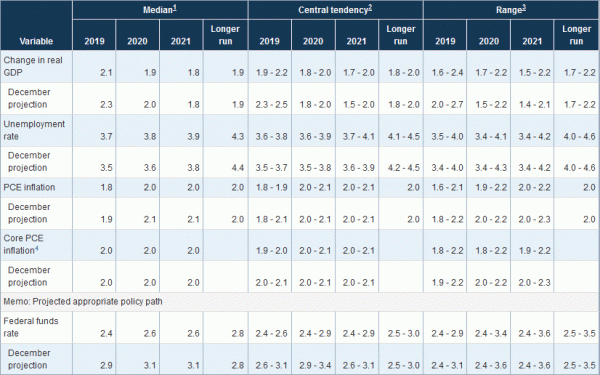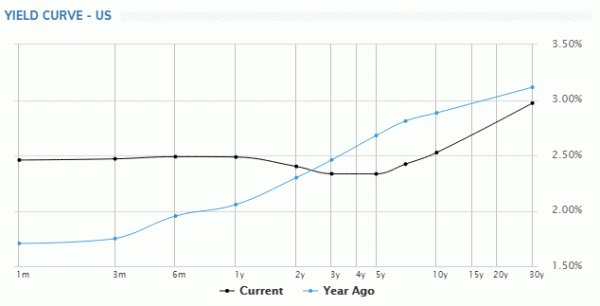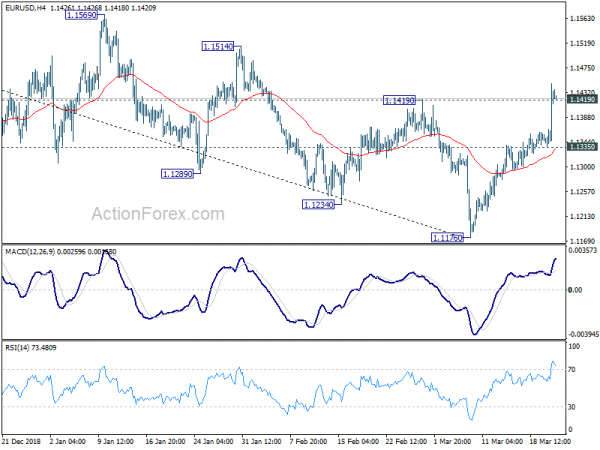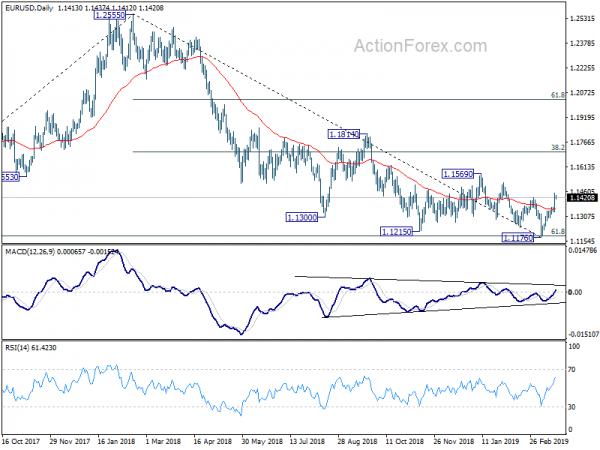Dollar tumbled sharply overnight as FOMC economic projected turned out to be much more dovish than expected. Selling continues today, in particular against the Japanese Yen, which is lifted broadly on after the sharp decline in US treasury yields, in response to FOMC. While stock markets are just mixed, risks are piling quickly. Firstly, Fed’s dovishness now pushed the most reliable part of the yield curve on the brink of indicating recession. Secondly, Trump hinted that he’s going to extend the ongoing trade war with China even if the latter agrees to a trade deal. The damage to the world economy by the two countries could extend for a long-period of time.
Staying in the currency markets, Canadian Dollar is the second weakest for today even though WTI crude oil surged through 60 handle on sharp decline in oil inventory. New Zealand Dollar is the strongest one following solid rebound in Q4 GDP. Australian Dollar follows as unemployment rate dropped to lowest since 2011. Sterling is mixed for today even though it’s the weakest one for the week. EU summit in Brussels will be watched for formal responses to UK’s request for Article 50 extension.
Technically, EUR/USD’s break of 1.1419 resistance is taken as the first sign of medium term bottoming. Focus will now turn to 1.1569 resistance in near term. Similarly, USD/CHF break of 0.9926 support also suggests medium term topping. Focus will turn to 0.9716 support. USD/JPY will take on 110.35 key support to confirm near term bearish reversal too.
In Asia, Japan is on holiday. Hong Kong HSI is up 0.17%. China SSE is up 0.94% at 3119, back above 3100 handle. Singapore Strait Times is up 0.14%. Overnight, DOW dropped -0.55%. S&P 500 dropped -0.29%. But NASDAQ rose 0.06%. 10-year yield dropped -0.079 to 2.525. 30-year yield dropped -0.053 to 2.975, lost 3% handle.
Dovish Fed projections point to no hike in 2019, slower GDP growth and higher unemployment rate
Fed left federal funds rate unchanged at 2.25-2.50% as widely expected. The statement offered no surprise at the committee will remain “patient” regarding future adjustments to interest rates. Fed also decided to terminate the balance sheet reduction plan in September this year.
The shocks came from the all-round, deeply dovish economic projections. In short, there will be no more rate hike in this year. And the current rate hike cycle could end with interest rate below longer run rate. GDP forecasts for 2019 and 2020 are revised down. Unemployment rate for 2019, 2020, and 2021 are all revised up.
Federal funds rates are projected to be at: 2.4% in 2019, revised down from 2.9%; 2.6% in 2020, revised down from 3.1%; 2.6% in 2021, revised down from 3.1%. Median longer run rate is unchanged at 2.8%. That is, there will be no rate hike this year. And probably just one hike in 2020 and it’s done. The current cycle could end up with interest rate below the longer run level.
GDP growth is projected to be at: 2.1% in 2019, revised down from 2.3%; 1.9% in 2020, revised down from 2.0%; 1.8% in 20201, unchanged. Unemployment rate is projected to be at; 3.7% in 2019, revised up from 3.5%; 3.8% in 2020, revised up from 3.6%; 3.9% in 2021, revised up from 3.8%. Core PCE inflation is projected to be at: 2.0% in 2019, unchanged; 2.0% in 2020, unchanged; 2.0% in 2021, unchanged.
Drastic moves were seen in the bond markets with yield curve now indicate intensified risks of recession ahead. The most reliable recession indicator is now flashing red after yesterday’s moves in the bond markets. The spread between 3-month yield and 10-year yield has narrowed sharply and at brink of inverting. The slope of 3-month and 10-year yields is watched by most economist and seen as the best recession indicator.
Suggested readings on FOMC:
- Fed Turns Even More Dovish in March – Downgrading Economic Outlook, Pausing Rate Hike Cycle, Ending Balance Sheet Reduction
- FOMC Thinks It Will Be On Hold Throughout 2019
- Northern Exposure: FOMC in a Good Place
- Fed Keeps Rates Steady as the Dots Fall
- FOMC Recap: Doves On Parade!
- Another Dovish FOMC Meeting Sees 2019 Rate Hike Plans Abandoned
- Fed chair Jerome Powell press conference live stream
- Fed Goes All in on Dovish Commitment (Dot Plots No More Hikes in 2019)
Trump hints at extending trade war and keep tariffs on China for a long period of time
Trump said his administration is talking about leaving tariffs on China for a long period of time. That is, even if a trade agreement is reached, the tariffs won’t be limited until China complies with the terms of the deal. His comments come just ahead of USTR Lighthizer’s trip to Beijing next week to resume the negotiation.
He said: “We’re not talking about removing them, we’re talking about leaving them for a substantial period of time, because we have to make sure that if we do the deal with China that China lives by the deal. Trump also criticized that China had a lot of problems living by certain deals.”
China has yet to have a formal response to the comments yet. But what Trump said were generally seen as counter productive to the negotiation, as well as the world economy. Without US stopping the punitive tariffs, China will certainly not agree to correcting its unfair trade practice while lifting its own retaliatory tariffs at the same time. The US won’t have it all. That is, even if there is an eventual agreement and China will speed up it’s reforms, tariffs from both sides will stay there for much longer.
As we emphasized before, there is no trade truce for now, no ceasefire. The tariffs are the “cannons” of trade war and they are bombing both economies everyday right now. They’re hurting the world too and will continue to do so for a long period of time as Trump indicated.
EU would grant short Brexit delay only if Commons approve the deal
UK Prime Minister Theresa May formally wrote a letter to European Council President Donald Tusk yesterday, seeking for Article 50 extension until June 30. The date itself is debatable already as EU insisted it couldn’t be later than May 23, when EU elections are held. The issue right now is that EU has given quite unified response that UK could be granted an extension only on condition that the Brexit deal is approved by the Commons.
In statement, Tusk offered to give short Article 50 extension. But that would be “conditional on a positive vote on the withdrawal agreement in the House of Commons.” If his proposal is approved by all other 27 EU members, and there is a positive vote in the House of Commons next week, the EU can “finalize and formalize the decision on extension in the written procedure”. Tusk is ready to call for another EU summit next week if needed.
This position is rather unified in the EU as officials repeated emphasized that there much be a purpose for the extension, be it until May 23 or June 30. But then, the question remains on whether May could secure enough support for her deal. It remains a developing story.
May said at her Downing Street residence that the Brexit delay is “a matter of great personal regret”. She added “I passionately hope that (MPs) will find a way to back the deal I have negotiated with the EU, a deal that delivers on the referendum and is the very best deal negotiable, and I will continue to work night and day to secure the support” for the deal. Though, she emphasized she’s not preferred t delay Brexit any further than June 30.
Australia unemployment rate dropped to 4.9% as participation rate dropped -0.2%
In seasonally adjusted term, Australian employment market grew 4.6k in February, well below expectation of 15.2k. Full-time employment dropped -7.3k while part-time jobs grew 11.9k. Unemployment rate dropped to 4.9%, down from 5.0%. That’s also the lowest level since June 2011. However, participation rate dropped by -0.2% to 65.6%.
The seasonally adjusted unemployment rate increased in New South Wales (up 0.3 pts to 4.3%) and Victoria (up 0.2 pts to 4.8%). Decreases were observed in Western Australia (down 0.9 pts to 5.9%), Queensland (down 0.6 pts to 5.4%), South Australia (down 0.6 pts to 5.7%) and Tasmania (down 0.5 pts to 6.5%).
ABS Chief Economist Bruce Hockman said: “The trend unemployment rate declined 0.5 percentage points over the year, from 5.5 per cent to 5.0 per cent. The pace of decline slowed in recent months, which was consistent with the slowdown seen in recent Job Vacancies and GDP numbers.”
New Zealand GDP grew 0.6% qoq, led by services
New Zealand GDP grew 0.6% qoq in Q4, up from Q3’s 0.3% qoq and matched expectations. GDP grew 2.8% over the year ended December 2018. While the 0.6% growth missed RBNZ’s forecast of 0.8%, it may not be weak enough to prompt an RBNZ rate cut in this month’s meeting yet.
Looking at the details, growth was driven by services industries which rose 0.9%, with 9 of 11 services industries recording increases. Agriculture, forestry, and fishing industry contracted -0.6%. construction rose 1.8%. Household spending rose 1.3%. Investment spending rose 1.4%.
Looking ahead – SNB and BoE unlikely to offer any more surprises
SNB and BoE rate decisions are the main focuses of today. Both are expected to stand pat and are unlikely to offer any surprises. SNB is expected to keep the sight deposit rate at -0.75%. The three-month Libor target range should be held at -1.25% to -0.25% too. The central bank should also maintain that it’s necessary to keep interest rate negative and pledge to intervene in the forex markets when needed.
BoE is also expected to keep bank rate unchanged at 0.75%. The asset purchase target should be held at GBP 435B. BoE will also reiterate that the economic outlook will depend significantly on the nature of Brexit, hard or soft, abrupt or smooth. Also, it will be reiterated that the monetary path following Brexit will not be automatic and could be in either direction.
On the data front, UK will release retail sales; Canada will release wholesale sales. US will release jobless claims, Philly Fed survey and leading index.
Suggested readings on BoE and SNB:
- BOE Preview – Staying Cautious Despite Temporary Bounce in Economic Data. Brexit Uncertainty Remains
- SNB: Staying Dovish, Preventing Franc Strength
EUR/USD Daily Outlook
Daily Pivots: (S1) 1.1349; (P) 1.1398; (R1) 1.1462; More…..
EUR/USD’s rebound from 1.1176 accelerated to as high as 1.1448. The break of 1.1419 resistance is taken as the first sign of medium term bottom. Intraday bias is now on the upside for 1.1514/1569 resistance zone first. On the downside, break of 1.1335 minor support is needed to indication completion of the rise from 1.1176. Otherwise, near term outlook will remain cautiously bullish in case of retreat.
In the bigger picture, current development suggests that a medium term bottom could be formed at 1.1176 already. That came after hitting 61.8% retracement of 1.0339 (2016 low) to 1.2555 (2018 high) at 1.1186, on bullish convergence condition in daily MACD. Further rally could be seen back to 38.2% retracement of 1.2555 to 1.1176 at 1.1703. It’s a bit early to confirm medium term bullish reversal. The structure of the rise from 1.1176 and reaction to 1.1703 fibonacci level will be watched for making an assessment later. But in any case, decisive break of 1.1176 is needed to confirm resumption of down trend. Otherwise, outlook is neutral at worst.
Economic Indicators Update
| GMT | Ccy | Events | Actual | Forecast | Previous | Revised |
|---|---|---|---|---|---|---|
| 21:45 | NZD | GDP Q/Q Q4 | 0.60% | 0.60% | 0.30% | |
| 0:30 | AUD | Employment Change Feb | 4.6K | 15.2K | 39.1K | 38.3K |
| 0:30 | AUD | Unemployment Rate Feb | 4.90% | 5.00% | 5.00% | |
| 8:30 | CHF | SNB Sight Deposit Interest Rate | -0.75% | -0.75% | ||
| 8:30 | CHF | SNB 3-Month Libor Upper Target Range | -0.25% | -0.25% | ||
| 8:30 | CHF | SNB 3-Month Libor Lower Target Range | -1.25% | -1.25% | ||
| 9:00 | EUR | ECB Monthly Bulletin | ||||
| 9:30 | GBP | Public Sector Net Borrowing (GBP) Feb | -0.3B | -15.8B | ||
| 9:30 | GBP | Retail Sales Inc Auto Fuel M/M Feb | -0.40% | 1.00% | ||
| 9:30 | GBP | Retail Sales Inc Auto Fuel Y/Y Feb | 3.30% | 4.20% | ||
| 9:30 | GBP | Retail Sales Ex Auto Fuel M/M Feb | -0.40% | 1.20% | ||
| 9:30 | GBP | Retail Sales Ex Auto Fuel Y/Y Feb | 3.50% | 4.10% | ||
| 12:00 | GBP | BoE Rate Decsion | 0.75% | 0.75% | ||
| 12:00 | GBP | BoE Asset Purchase Target Mar | 435B | 435B | ||
| 12:00 | GBP | MPC Official Bank Rate Votes | 0–0–9 | 0–0–9 | ||
| 12:00 | GBP | MPC Asset Purchase Facility Votes | 0–0–9 | 0–0–9 | ||
| 12:30 | CAD | Wholesale Trade Sales M/M Jan | 0.50% | 0.30% | ||
| 12:30 | USD | Philadelphia Fed Business Outlook Mar | 5 | -4.1 | ||
| 12:30 | USD | Initial Jobless Claims (MAR 16) | 226K | 229K | ||
| 14:00 | USD | Leading Index Feb | 0.10% | -0.10% | ||
| 14:30 | USD | Natural Gas Storage | -204B |

















